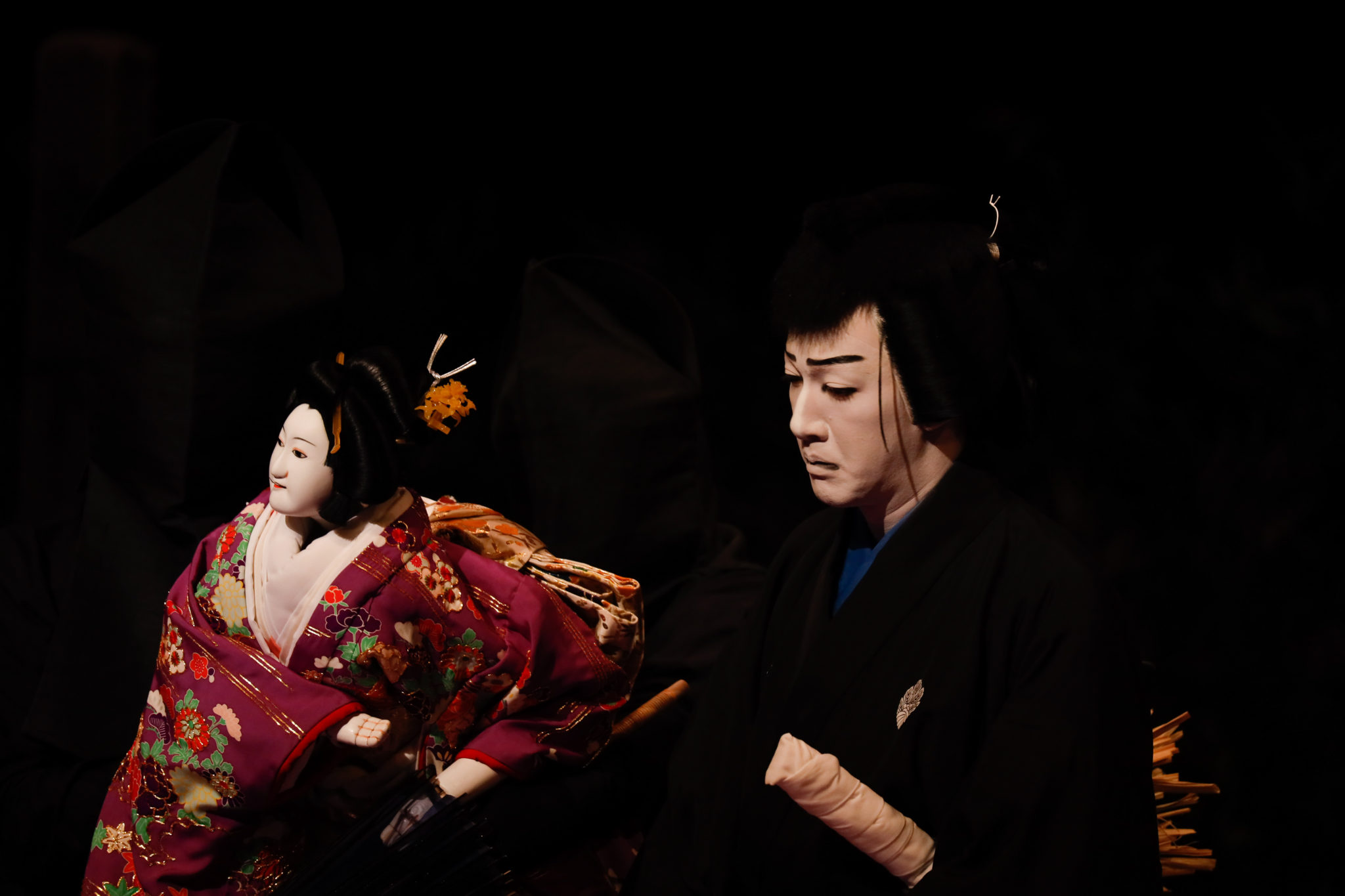Dance & Theater Critic. Previously worked as an editor for Magazine House, Ltd. (Brutus magazine, and books including Anne’s Cradle, the biography of Hanako Muraoka by Eri Muraoka, as well as Shakespeare’s Famous Quotationsby Haruo Nakano, and Ren Osugi‘sGembamon), and currently contributes to various media as a dance and theater critic, continuing to explore the relationship between art and society through all kinds of performing arts from classical to experimental pieces. She has been visiting numerous international festivals since the early 1990s, and also writes art reviews. Member of the International Association of Theatre Critics (AICT/IATC). Research Fellow at the Theatre Museum, Waseda University.
Photo: Masami Taguchi
Kabuki actor Onoe Ukon and bunraku puppets handled by Yoshida Minoshiro co-star in the dance drama “Kasane”
Amidst the Covid-19 pandemic, 2022 saw bold undertakings in the world of performing arts that pointed the way to a more hopeful future. The dance drama “Iro-Moyo Chotto Karimame” (more commonly, and in the rest of this review, referred to as “Kasane”), in which kabuki actors and bunraku puppets perform together, is a project that aspires to the evolution of the traditional performing arts. The work was performed as part of kabuki actor Onoe Ukon’s self-produced Ken no Kai series. Kabuki and bunraku, both art forms with long and illustrious histories, continue to experiment with new works, including ones based on Shakespeare’s plays, in keeping with contemporary tastes. In “Kasane,” which blurs the boundary between kabuki and bunraku, the classics as a source material brought about a new form of expression. Ukon was born into the renowned Kiyomoto family of kabuki musicians, and has also acted in film and television. The bunraku puppets were handled by Yoshida Minoshiro, while Ukon’s father, Kiyomoto Enjyudayu narrated the puppets’ words, and his brother Saiju played the shamisen.
The legend of Kasane, a tale of grudges and exorcism, has been told since the Edo period, being adapted to a variety of bunraku and rakugo (traditional storytelling) works. Let’s take a look at the plot of “Kasane,” one of these works. Kasane, a maid in the household of a samurai lord, falls in love with and becomes pregnant by Yoemon, not knowing that this man murdered her father after having an illicit affair with her mother. Just as the two are about to fulfill their suicide pact by throwing themselves in the Kinugawa River, a skull with a sickle in its eye socket floats by on a grave post. Seeing this, Yoemon realizes that he is being haunted by his victim’s vengeful spirit and points the sickle at Kasane…The gruesome dance drama (penned by Matsui Kozo) was originally an interlude in Tsuruya Nanboku’s kabuki play “Kesakakematsu Narita no Riken,” first performed in 1823. Kasane resembles Oiwa, the heroine of “Yotsuya Kaidan” (1825) —another work by Nanboku, an author noted for a style that mixes cruelty with humor—in that her face is also disfigured and she becomes a ghost after death.
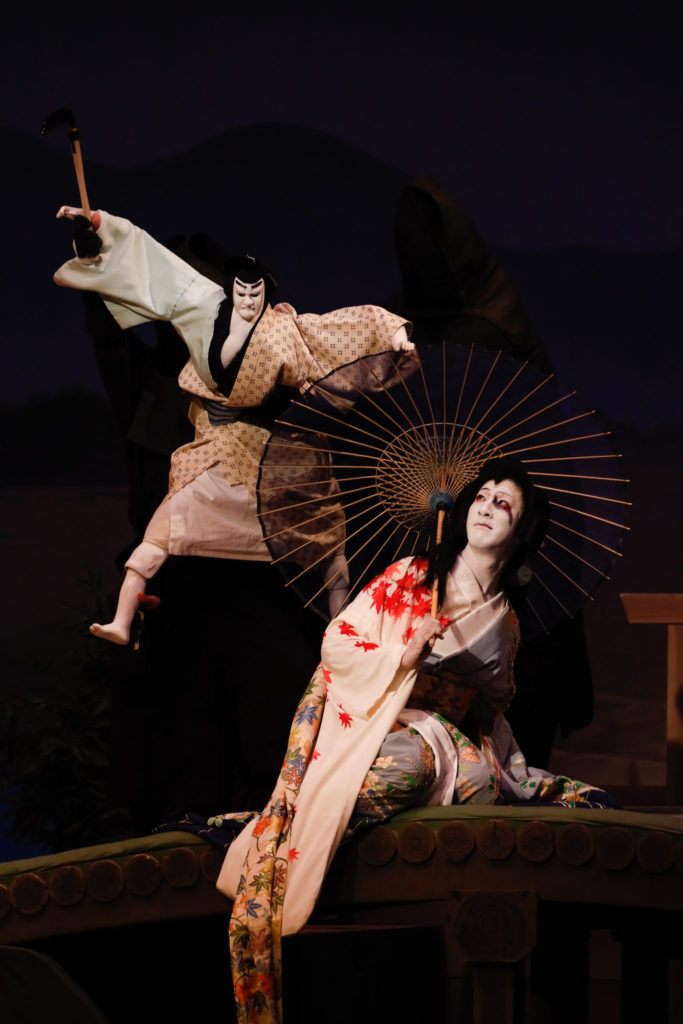
The spirited exchange between the deformed Kasane (Ukon) and Yoemon (Minoshiro), who harbors a murderous intent. The interplay between actor and puppet conjures up a fear different in kind than that between flesh-and-blood counterparts. Photo: Masami Taguchi
Ukon alternated in the roles of Kasane and Yoemon from performance to performance, while Minoshiro also handled the puppets for both. The performance I saw had Ukon playing the role of Kasane. His distinctive ability to portray both onnagata (female roles) and tachiyaku (male roles) was demonstrated by his adept switching between male and female genders and roles. An up-and-coming actor known for taking on contemporary roles in TV dramas and variety shows, Ukon’s range—transforming to and from a beautiful woman in love, an evil woman with scars both physical and mental, a vengeful spirit possessed by delusion, and a likeable boatman named Yokichi—left a vivid impression on the audience.
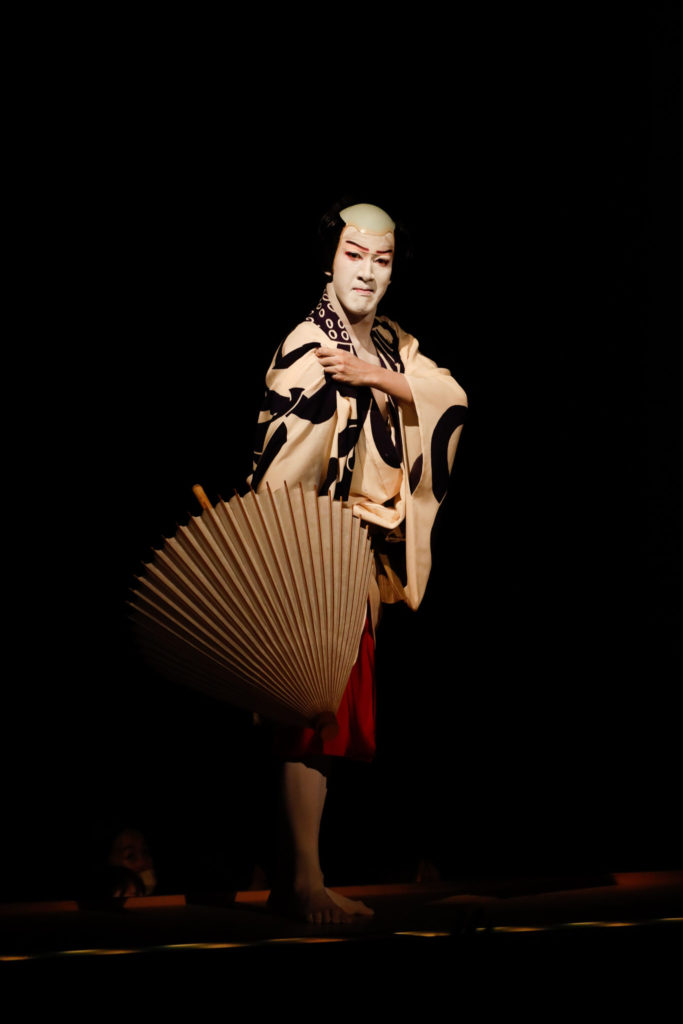
Ukon, who switches between male and female genders and roles, transforms into a dapper boatman at the end of the act. Photo: Masami Taguchi
The effect created by the coordination between puppets and actors was the highlight of the performance. For example, when the puppet playing Yoemon attacked Kasane, the sickle in his hand appeared to be enlarged, reminding one of the Grim Reaper. Also thrilling was the process of the dominant side being switched. When Yoemon broke Kasane’s father’s grave post, her leg began to hurt, and when he pulled the sickle from the skull, a bruise appeared around her left eye. The puppet Yoemon dominated in the scene where he holds up a mirror to the suffering Kasane and makes her wail, “Is this what’s become of my face?” But the balance of power was reversed in the final scene of fighting, when Kasane dishevels her hair and obi in her pursuit of Yoemon. Her appearance grew ever more deformed, taking on the air of someone risen from the underworld. When she was finally killed and became a ghost, she began to pull back the man escaping along the hanamichi runway, in a display of renribiki (a technique in which a “fleeing” actor moves as if he is being pulled back by an invisible thread, usually depicting the supernatural power of a vengeful female ghost over the man who killed her) that radiated the mystique of the netherworld. Here, however, Yoemon—reduced to a weakling being manipulated by the ghost—began to leap like only a puppet can. If only the movement of the man being pulled and spun against his will by the woman’s passion had been made clearer, the bunraku puppet would have matched the actor, with the audience’s imagination surely stirred further.
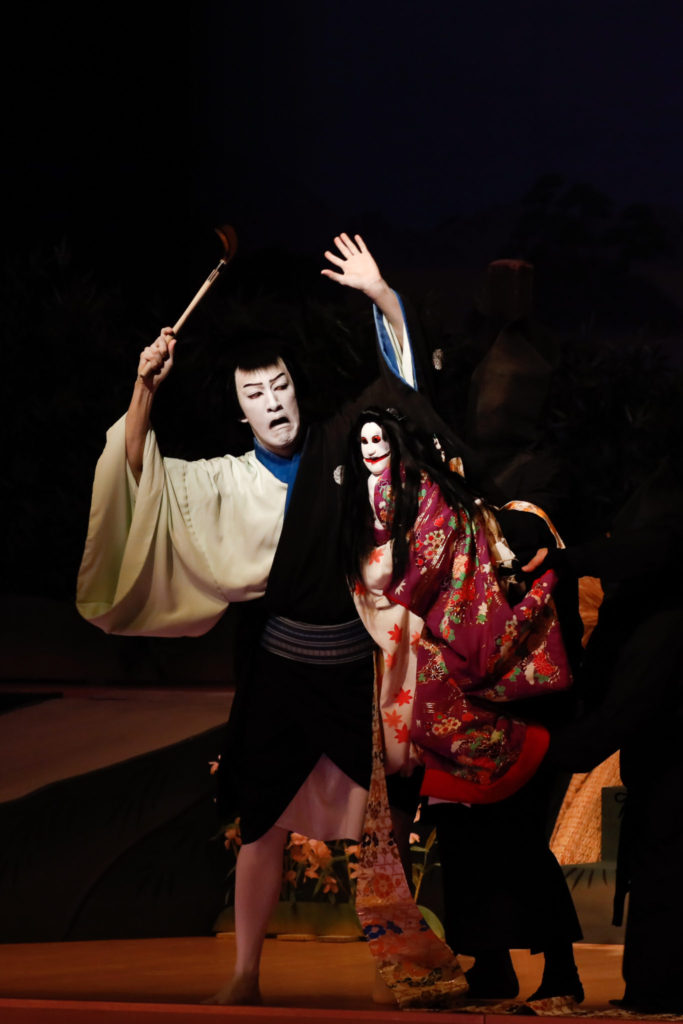
The puppet representing the graceful Kasane is turned into a vehicle for burning resentment by using a gabu (a neck with an elaborate device that causes the mouth to split open in an instant and turn the eyes red). The autumn leaves scattered on the sleeves of the juban underwear symbolize splashes of blood. Photo: Masami Taguchi
After watching the play, what stuck with me was both fascination with this rare attempt at interdisciplinarity and the difficulty of striking a balance between human and puppet. Due in part to the difference in structure between kabuki and bunraku stages, the puppets floating in the air sometimes looked out of place. At such times, both Yoemon’s charm as an attractive but despicable villain and his deep bond with Kasane were diminished. In order to bring the two closer together, aspects such as the positioning of the characters, the lighting, and stage devices may need to be reconsidered. But provided that this fusion of kabuki and bunraku is refined in the future, it may well attract the interest of viewers across genres and borders. Le Théâtre du Soleil, led by the French director Ariane Mnouchkine (whose “Tambours sur la Digue [The Drummers on the Embankment]” by Hélène Cixous premiered in 1999 and was performed at the New National Theatre in 2001), has also used bunraku and kabuki as creative fodder to foster a new style of performance. Works from Japan, where a variety of traditional performing arts coexist, could also inspire pioneers of expression and audiences around the world. In addition, a richly experimental work such as “Kasane” has the potential to broaden interest in the classics.
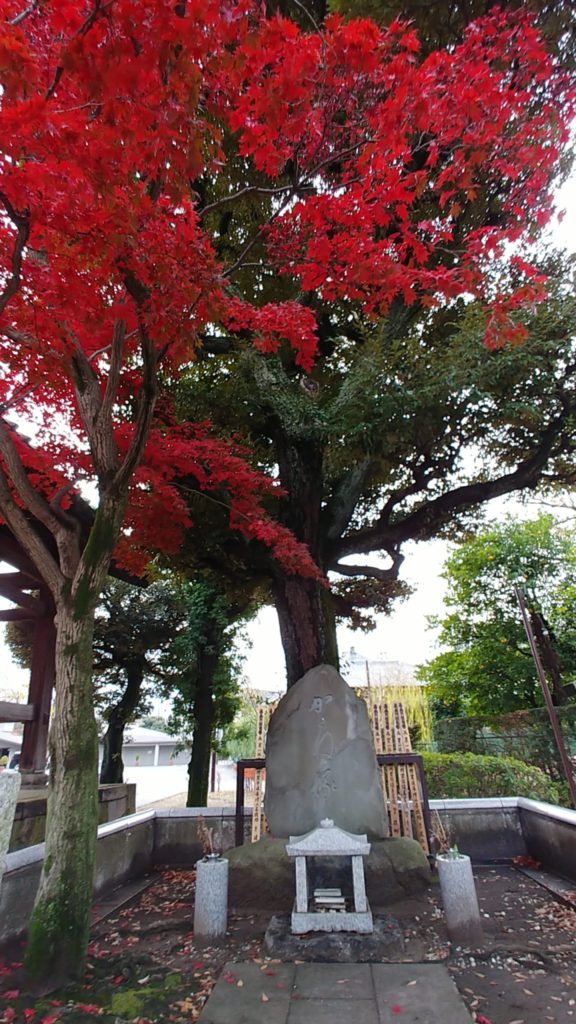
Autumn leaves at Yutenji’s Kasanezuka echoing the pattern of Kasane’s juban underwear, which represents bloodshed. Photo: Mana KATSURA
Allow me to conclude by introducing Kasanezuka, a stone monument at Yutenji Temple in Meguro, which was founded in 1718, in the mid-Edo period. After a long absence from the stage, “Kasane” was performed again in 1920 to great acclaim. Six years later, Ukon’s great-grandfather Enjyudayu V and some kabuki actors erected the Kasanezuka at Yutenji—a temple associated with Yuten Shonin, a high-ranking priest of the Edo period who is said to have appeased the spirit of Kasane so that she could pass into the afterlife. When I visited the Kasanezuka this fall, I was struck by the autumn foliage above me and on the ground. Nestled against the monument was a tree that reminded me of Kasane’s juban (underwear worn with kimono), its crimson leaves resembling tides of blood.
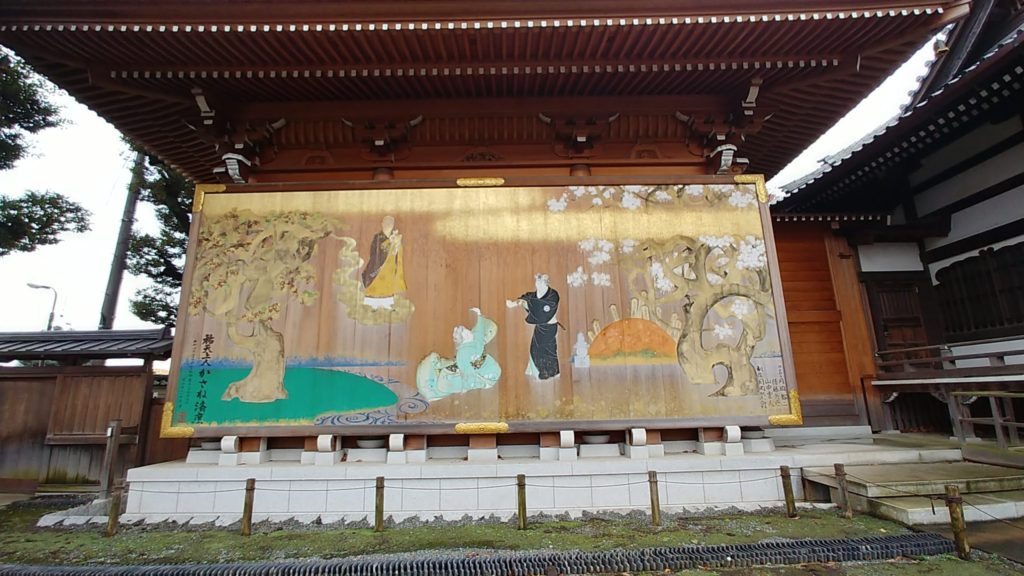
The painting on the wall of the reliquary hall, “Yuten Shonin Kasane Saido” (“The Salvation of Kasane by Yuten Shonin,” 1986, by Tsukioka Eiki), depicts Kasane and Yoemon by the river, as well as Yuten Shonin, who liberated Kasane’s vengeful spirit. Photo: Mana KATSURA
Translated by Ilmari Saarinen
INFORMATION
Kasane—Iro-Moyo Chotto Karimame
Dates: August 22-23, 2022
Venue: National Theatre of Japan, Small Hall
Organizers and creators: Office of Onoe Ukon, Hagimori Yukikazu
Choreography: Fujima Kanjuro
Cast: Onoe Ukon, Yoshida Minoshiro (Ningyo-Joruri Bunraku-za)


